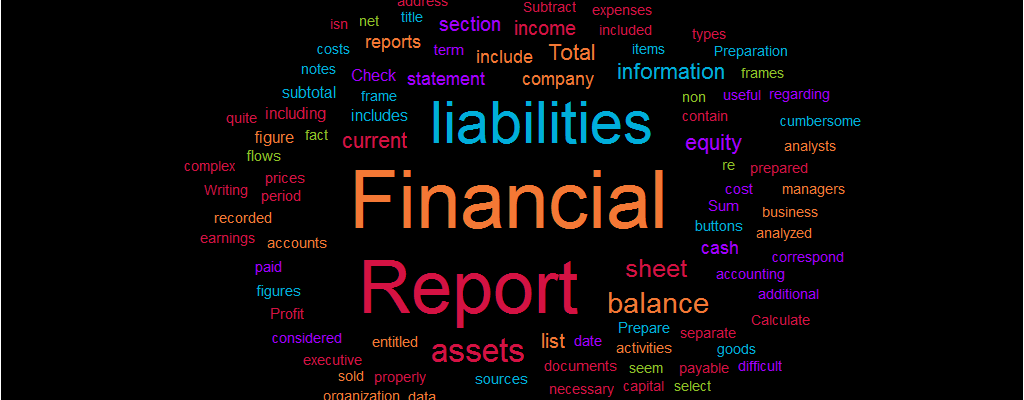How to Write a Financial Report
Publication Date:

A financial report is a complex paper that includes information on the income and cash flows, along with a balance sheet. Such reports are analyzed by directors, business managers, investors, government agencies, and analysts. Writing a financial report may seem to be quite difficult but in fact, the accounting required isn’t cumbersome.
Preparation
First of all, select the considered period. There are several types of financial reports regarding time frames. Some of them are prepared annually or quarterly, while some companies prefer monthly reports.
If you’re not sure about the time frame, get acquainted with governing documents of your company. Check articles of incorporation and bylaws. Usually, such documents contain information on how often reports should be prepared.
You also can get more information by asking your executive. If you’re the executive, you have to decide when reports can be most useful and define a necessary date of the financial report.
Once you’ve clarified the date, make sure that your ledgers are relevant. They must be recorded properly, and all data must be correct in order to make the report useful for readers.
- All sales and purchases should be recorded. Check if the bank reconciliation is complete and all accounts were processed.
- Pay your attention to any liabilities that may not have been recorded. Check wages that haven’t been paid yet and any services that haven’t been invoiced. Information on all these items must be included in the financial statements.
While preparing a review, you may realize that some information is missing. In this case, you have to find it by tracking down the related documents.
Prepare the Balance Sheet
A balance sheet includes liabilities of your company along with its assets and equity accounts, such as a stock capital and a paid-in capital for a particular period. The title of the balance should include the date and names of organizations.
Balance sheets must be properly formatted. Usually, the sheet is divided into two parts. The left one (or the top one) includes assets, while the right one (or the bottom one) includes equity and liabilities.
The first section of the balance sheet is devoted to assets. Here you have to list current assets and the subtotal of the current assets. After that, list non-current assets, including any items that can be converted to a cash form, and a subtotal of these assets. Sum these two parts on a separate line entitled “Total Assets”.
The next section is focused on equity and liabilities. Thus, it must be titled “Liabilities and Equity”. First, list current liabilities, such as one-year-long liabilities that include payable accounts, short-term loan payments, and accrued liabilities. Draw up a subtotal of the current liabilities.
Next section must include long-term liabilities, such as payable notes and long-term debt, as well as a subtotal of these figures. The separate line entitled “Total Liabilities” must contain non-current and current liabilities summarized.
After this, prepare a list of all equity sources, including the amount of money that may remain if all liabilities were paid and all assets were sold. Sum up total equities with liabilities.
Make sure that the figures calculated in “Total Liabilities and Equity” and “Total Assets” sections are equal on the balance sheet. If they are not, check your work a couple times to make sure all necessary figures are included. When this part of the financial report is finished, you can start preparing the income statement.
Income Statement
This page provides information on earnings and costs for a certain period of time. The title must include the name of the organization and considered time frame.
First, list all sources of income, along with amounts of money earned The sources must be organized in a way that is most informative for the company. You may include data on geographical regions or management teams.
Calculate the cost of goods sold. This figure will illustrate the total cost of providing your service or manufacturing your product. You have to take into account costs of materials, labor, shipping, and other additional expenses. Subtract the cost of goods from the total revenue and you will obtain the “Gross Profit” figure.
After this, calculate operating expenses, and subtract this figure from the gross profit. Write this figure in a “Profit Before Taxes” line.
The last part of the income statement should address retained earnings, including net losses and net income from the day the organization was founded.
Prepare a Statement of Cash Flows
Finally, write a statement of Cash Flows. Start by listing the operating activities of the company. In the next section, list investing activities that must correspond to the balance sheet. The last part of this section must address financing activities that correspond to the equity presented in the balance sheet.
You have to sum up all categories and create the last section entitled “Decrease or Increase of Cash”. You can add some notes if needed, including additional information on the future of the company, accounting practices, and pension plans.